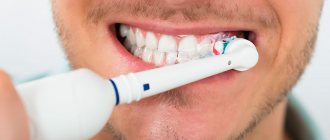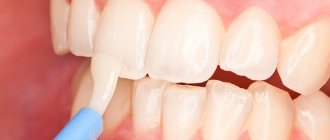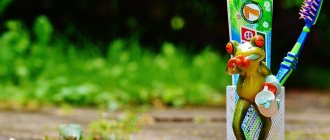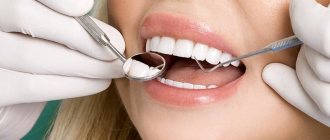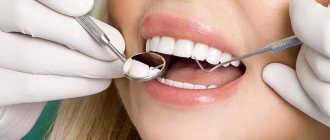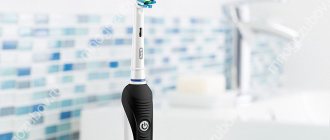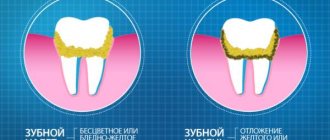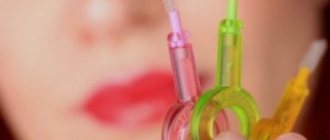The long and interesting history of the toothbrush began thousands of years ago, when various chewing sticks began to be used as brushes.
The brush, which resembled a tuft of bristles on a stick, came to Russia during the time of Ivan the Terrible. Since those distant times, the brush mechanism has undergone considerable changes, and today it is increasingly difficult to choose this item for maintaining oral hygiene, because there are too many brushes, and every year they become more perfect and functional.
All types of toothbrushes today - regular, electric, ionic, ultrasonic, etc.
Once every few months we go to the store (or pharmacy) and are faced with a difficult choice - which brush to choose that is inexpensive, cleans well, and doesn’t “cut” our gums.
And, as a rule, we take the first one we come across at a reasonable price, because “who cares!”
But there is a difference. And not only the cleanliness of the teeth, but also the quality of the enamel, the condition of the gums, etc. will depend on the correct choice of brush.
Therefore, before you go for a brush, study the basic rules of choice.
How to make the right choice?
The classification of toothbrushes clearly shows how great their diversity is. To make the right choice for your oral health, you need to know the condition of your teeth and gums. Therefore, it is advisable to discuss the choice of a brush for yourself or your child with your dentist after a thorough examination of the oral cavity. The specialist will recommend which toothbrush model can most effectively solve individual hygiene problems and advise additional oral care products.
You can always purchase a high-quality toothbrush and other oral hygiene products in our online store.
The types of bristle hardness are as follows:
- Very soft (approx. - ultrasoft, extrasoft, sensitive). Suitable for children under 5 years of age and for adults with very sensitive enamel and gums, stage 1-2 periodontitis, and enamel damage.
- Soft (approx. - soft). Indicated for expectant and nursing mothers, children aged 5-12 years, as well as for diabetes and bleeding gums.
- Average (approx. - medium). The most popular brush for healthy enamel and oral cavity for adults and children over 12 years old.
- Hard and very hard (approx. – hard, extra-hard). An option for adults who are familiar firsthand with the rapid formation of plaque. And also for people using braces and other orthodontic structures.
And now a little about the material from which the brushes are made.
No matter how popular the idea that everything and everywhere is natural, dentists categorically do not recommend brushes with natural bristles.
Key selection criteria
Since choosing a good brush is not easy, you need to approach this issue as responsibly as possible and understand what points you should pay special attention to. Below are the main criteria that you should follow when choosing the right option for yourself.
How stiff should the bristles be?
Toothbrushes vary in hardness. This indicator will definitely be indicated on the packaging. Let's consider the main varieties based on this criterion:
- very soft - indicated for young children and adults with problem gums and sensitive enamel,
- soft - recommended for sensitive gums prone to bleeding, as well as for people suffering from diabetes, women during pregnancy and breastfeeding. If the teeth and gums are in normal condition, it will not cope well with removing plaque and will not give the desired effect, so they also use it according to the indications of a specialist,
- medium – a universal option for healthy teeth and mucous membranes,
- hard - a suitable choice for smokers and those people whose lifestyle or professional activities lead to the formation of abundant deposits. Long-term use can cause hyperesthesia and bleeding gums,
- very hard - these are special models that can be used to clean removable and fixed prosthetic structures or braces. It is not recommended to make a choice in favor of this option on your own - only as prescribed by a doctor.
It is important to pay attention to the stiffness of the bristles
. In general, when choosing a suitable model, you should rely on the opinion of a specialist. After examining and taking into account the patient's complaints, he will be able to determine which option is more preferable for this particular case.
Pile material
As mentioned above, it is better to choose specimens with artificial pile. Particles of plaque remain in the natural bristles, bacteria settle, which multiply quickly and can cause infection of oral tissues. In addition, natural hairs are too soft and cannot effectively remove plaque. At the same time, they are pointed at the ends, which can lead to scratches on the mucous membrane.
Models with artificial pile are usually made from nylon. The material undergoes special treatment, after which it becomes more resistant to the activity of harmful microorganisms.
Other criteria: size, performance characteristics, etc.
Bunches of bristles are located on the working area, and can be directed in one or different directions, be the same or different lengths. In this regard, several types of toothbrushes can be distinguished: one-, two- and three-level, as well as multi-level. A two-level model is considered a universal option, since it allows you to effectively remove plaque from all sides of the tooth. The size of the head also plays an important role. The optimal size will be small - up to 30 mm (covers 2-2.5 teeth)1.
There are several types of toothbrushes
And there are several reasons:
- In such brushes, bacteria multiply 2 times faster, and, accordingly, they will also have to be changed more often.
- In addition, the tips of pig bristles (yes, it is from this bristle that brushes labeled “natural” are made) cannot be rounded, and they can significantly injure the gums and the enamel itself.
- It is also worth noting that natural bristles quickly lose their shape and properties - they fluff up and break.
Therefore, the ideal option is nylon bristles and a handle made of safe plastic.
Electrical
Electric brushes have a number of advantages. They operate on batteries or an accumulator and provide a more thorough cleaning of plaque than conventional ones. However, their use has a number of limitations. Thus, electric brushes are contraindicated for periodontal disease, stomatitis, gingivitis, and recent oncological operations in the oral cavity.
Important! Healthy people can use an electric brush no more than twice a week. This is due to the fact that it tends to quickly erase enamel.
Electric brushes come in mechanical, sonic and ionic types.
Mechanical
Mechanical devices, in turn, are divided into reciprocating and combined ones. In the first case, the brush head moves both in a circle, rotating sideways, and vertically. In combined devices, additional cross-bristles are installed on the head, which effectively clean areas that a simple brush cannot handle.
Ultrasonic and ion
Electric brushes that operate using sound technology are equipped with a special generator. It produces sound or ultrasonic waves. Sonic helps soften plaque and food debris. At the same time, the bristles moving at increased speed quickly clean the oral cavity. Ultrasound acts non-contactly, destroying bacteria and removing plaque.
An ultrasonic toothbrush effectively removes plaque on teeth, but there are limitations to its use
Ultrasonic brushes are a fairly new development. They are considered effective in removing plaque from teeth. The principle of their operation is low-frequency vibration of sound waves - this provides a clear positive result. An ultrasonic brush looks like an electric one.
Attention! Ultrasonic brushes are contraindicated for pregnant women. They should not be used by those who suffer from cancer of the oral cavity and have disturbances in the process of keratinization of the mucosal epithelium.
Ionic brushes were also invented more recently. They work on the basis of a rod that is coated with titanium dioxide particles. By combining with liquid, in particular saliva, the component attracts hydrogen ions, which in turn help destroy pathogenic bacteria and eliminate the acidic environment that negatively affects the oral cavity. Ionic brushes can be used without toothpaste.
This type of brush is contraindicated for smokers. This is due to the fact that nicotine, interacting with ions, leads to the destruction of the walls of the mucous membranes. It should also not be used for oncological diseases or for rapid drying of the oral cavity.
Toothbrush sizes and cleaning head shape – what is important?
- The ideal length of the working section of the brush is simply checked - the brush should capture 2-2.5 teeth. Only then is the maximum cleaning effect achieved for the chewing group of teeth.
- The length of the brush head, which is chosen for children, is 18-25 mm, for fathers and mothers – a maximum of 30 mm.
- No corners - only rounded shapes to reduce the risk of injury to the mucous membrane to a minimum.
- The area where the brush head connects to the handle must be movable so that the “spring effect” reduces pressure on the soft and hard tissues in the mouth.
- As for the handle , it should be thick, fit comfortably in the hand and have special anti-slip inserts.
A few more recommendations from experts
To get the maximum effect from each procedure, you should follow the correct teeth brushing technique. Movements should not be horizontal, but vertical - this applies to the front incisors and canines. Back teeth can be brushed horizontally, but special attention must be paid to the chewing surface. To maintain the proper level of hygiene, you should also rinse your mouth after each meal, use dental floss and purchase an irrigator. This is a small device that delivers a stream of water and air under high pressure to more accurately clean hard-to-reach areas.
- Baluda M.I. Clinical and laboratory assessment of the effectiveness and quality of toothbrushes, 2012.
Selecting a brush based on the location of the tufts:
- Hygienic : the bundles are even and straight, of the same length. Most often, this option is found among children's brushes.
- Preventive . On these brushes, the tufts can be located in completely different directions and can have different lengths and hardness. There may also be rubber bristles on the sides to massage the gums.
- Special . Option for cleaning plaque from implants, etc. Buy in pharmacies or to order.
Regular brushes
The simplest option is simple brushes. They are classified according to several characteristics. One of the main ones is the stiffness of the bristles.
People with significant plaque on their teeth are recommended to use a high-hardness brush. It must be used carefully so as not to damage the enamel and gums. To soften the fibers a little, it is recommended to hold them under running hot water before cleaning.
For most people who do not have oral problems, a regular, medium-hard brush is suitable.
Simple brushes have medium-hard bristles. This device is suitable for people without obvious problems who do not suffer from excessive plaque. A quality brush helps clean your mouth.
There are also combined products with mixed bristles. They involve alternating soft and hard fibers.
Brushes with soft bristles are suitable for children over 8 years old and people with oral diseases. Others should not use them, as they can cause pigment spots on the teeth.
There is a classification of brushes according to the stiffness of the bristles:
- Very soft (Sensitive)
- Soft
- Medium
- Hard
- Very hard (Xhard)
The correct shape of the working area and the number of beams is determined by the age of the patient, the number of teeth and the condition of the enamel. Thus, brushes with 23 tufts are suitable for children under 6 years of age. For adults, brushes with 40-55 tufts are used.
Those who wear braces are recommended to use special mono-beam instruments that can carefully penetrate the structure and remove plaque with food debris.
Another criterion is the location of the beams. In accordance with this feature, brushes come in the following types:
- Preventive
- Hygienic
- Special
Hygienic brushes have even, straight tufts of the same length. Typically, these options are used for children. Preventive devices can be bought at any store. They are equipped with beams of varying stiffness, length and directions. Some elements are aimed at cleaning plaque near the base of the tooth and at the gums, others - eliminating contaminants between the radical “sevens” and “eights”.
The brush for braces and implants has a special design
Special brushes are used to clean braces, implants and uneven teeth. They are usually sold in pharmacies.
Today, toothbrushes can boast the following features and additions:
- Rubber inserts on the handle so that the brush does not slip out of your hands.
- Rubber relief pad for cleaning the tongue on the back of the head.
- Indicator bristles that change color when it’s time to replace the brush with a new one.
- Multi-level and multi-directional bristles , allowing for maximum effective cleaning of teeth and dental spaces.
- Ribbed surface for gum massage.
- Use of silver ions (double effect).
How to choose the right brush
We have looked at the main characteristics of various toothbrush options, and now let’s move on to specific recommendations on how to correctly evaluate the quality and effectiveness of products. Let's talk separately about the choice for adults and children.
Recommendations for adult patients
When considering various options, you need to pay attention to criteria such as the degree of rigidity, the position of the bristles, their length and number. Moreover, the shape and length of the handle are also selected taking into account the condition of the teeth and gums, and the patient’s age. It is best to talk to your dentist in advance and get professional recommendations in this regard. The simplest and best option in terms of price and efficiency would be a conventional mechanical brush with synthetic bristles made of nylon. Natural bristles become dirty faster, bacteria accumulate in them, multiply and quickly render the tool unusable.
It is better if there is a ribbed surface on the back of the working area - it is intended to clean the tongue, which, by the way, accumulates the most bacteria. If you have the financial means and there are no problems with enamel sensitivity, you can give preference to an electric or ultrasonic model. We’ll talk more about assessing rigidity, material and size in the next section, but for now let’s move on to choosing the most suitable option for the child.
The ribbed surface on the back of the brush will help clean your tongue.
How to choose a brush for a child
By the age of 1.5-2 years, a baby usually already has about 15 teeth in his mouth. This is the best time to start getting him into the habit of brushing his teeth regularly twice every day. In this case, it is necessary to show the child to a specialist as soon as his first teeth begin to cut. And even before they appear, you should keep the baby’s mouth clean by regularly wiping the gums and mucous membranes using special finger wipes.
When a sufficient number of teeth appear, parents will be faced with the question: which brush is best to buy for their child. To avoid making a mistake with your choice, pay attention to the following points:
- appearance – the baby needs to be interested, and a bright, attractive design will help with this. With a brush of an unusual shape and colorful colors, the child will be more willing to brush his teeth every morning and evening,
- bristle parameters - for baby teeth, you need to ensure uniform pressure, and in this regard, even bristles are the best option. Length – no more than 11 mm. Medium and soft hardness is suitable for children - in this regard, you need to consult a dentist to take into account the current state of the enamel,
- working area - the head should not be too large, otherwise it will be uncomfortable to use and there will be a risk of damaging the mucous membrane. The working area should cover 2-3 children's teeth, and it is better to give preference to a round shape,
- handle – should be comfortable, optimal size for a child’s hand. It is better if it is covered with non-slip material. As you grow older, the length of the handle should increase.
Be responsible when choosing a toothbrush for your child.
Experts in the field of pediatric dentistry pay special attention to the change in primary occlusion. During this period, it is better to purchase a brush with multi-level bristles. The product must be replaced with a new one every 3 months.
Rules for caring for toothbrushes - how often do you need to replace toothbrushes with new ones?
Like all personal care products, brushes also have their own care rules:
- Each family member has his own brush.
- The brushes of different family members should not touch each other. Either you should use special caps (ventilated!), or a separate cup for each brush. This rule especially applies to children's and adult brushes: they are stored separately!
- It is not recommended to store a wet brush in a closed case - this will cause bacteria to multiply 2 times faster.
- Storing toothbrushes with razors or other similar tools is unacceptable!
- The maximum period for using a toothbrush is 3 months for medium hardness, 1-2 months for soft hardness.
- After each cleaning procedure, the instrument is thoroughly washed (laundry soap is recommended) and then put away to dry in a special glass.
- It is unacceptable for the brush to lie on a wet surface or sit sour in a long-unwashed common glass.
- Once a week, it is recommended to disinfect the brush with a special solution for teeth (note: antibacterial rinse).
- If there was treatment for gingivitis, stomatitis, etc. – the brush should be replaced immediately after recovery.
The site Colady.ru thanks you for your attention to the article - we hope that it was useful to you. Please share your feedback and tips with our readers!
The Best Oral-B Electric Brushes
Oral-B is the sole leader in the production of electric toothbrushes. Therefore, in many ratings their devices are in first place. Let's look at the most popular products from this manufacturer:
- Oral-B Vitality Precision Clean
is the most inexpensive and simplified model, the relatively low price of this model is due to the fact that it is devoid of additional functions, the mode of movement of the bristles in it is only horizontal, the battery life is enough for only 10 cleanings, and the full battery charge is quite long. But the main thing is that despite the modest set of functions, this brush cleans your teeth efficiently. - Oral-B Professional Care 500
is the most popular model, it has a charge indicator and a timer that allows you to set the operating time of the device. - Oral-B Professional Care 5000 D34
– compared to other models, this device has many more functions and capabilities; it comes with four attachments, one of which is whitening. This brush has five operating modes, including delicate cleaning, whitening and massage. The big advantage of this model is the existing pressure sensor, which allows you to control the degree of pressure of the bristles on the teeth. Its display displays a variety of information, for example, about the charge level, the need to change the nozzle, and more. The operating time of this model is longer and charging is faster.
Doctors have three reasons for this
- “Old” bristles often become filamentous, making cleaning less convenient and effective. Scratching particles can injure enamel and gums, and deformed fibers will not be able to penetrate hard-to-reach places.
- Old toothbrushes accumulate a large number of bacteria that can negatively affect the condition of tooth enamel.
- After any infectious disease, even a banal acute respiratory viral infection, the brush must be changed, since microbes remain on the bristles for a long time, which can lead to a recurrence of the disease. By the way, for the same reason it is not recommended to keep several brushes in one place. As a last resort, it is worth covering the heads with individual caps.
What materials are brushes made from?
Several centuries ago, the main materials of toothbrushes were natural wood or bone (the main part was made from them) and pig bristles (for the cleaning head). And although it was already known at the end of the 19th century that natural bristles are a favorable environment for the spread of microbes, this particular material was used for the manufacture of brushes for a long time.
A real revolution in the production of toothbrushes occurred in 1937, when the synthetic material nylon was invented. Unlike pig bristles, it did not promote the growth of microbes, dried quickly, was lightweight, durable, elastic, and highly resistant to moisture and chemicals. Nylon quickly became the number 1 material in toothbrushes.
The first brushes with nylon bristles were quite hard and scratched teeth and gums, but Du Pont soon synthesized a “soft” variety of nylon that was gentle on teeth and gums. This material is still used to make toothbrush bristles today. The handles of simple and electric brushes are made of plastic and are often rubberized for easy grip.
Age characteristics of buyers
The range of modern manufacturers includes models for people of different ages: small children from 6 months and older age groups. Taking this factor into account, hygiene items can be presented in the following variations:
- Toothbrushes for small children of preschool age. For users aged 6 months and older, silicone caps with soft bristles are designed to clean the surface of baby teeth from food debris.
- Children from 2 to 7 years old can use toothbrushes with a standard design, a small number of rows and low bristles. The main objective of such a procedure is to teach oral hygiene standards, which is why toothbrushes have a colorful design and are equipped with light and sound indicators for the end of cleaning.
- For school-age children and teenagers who have baby and permanent teeth, the brush has long bristles of varying lengths and a wide handle in bright colors.
- Toothbrushes for adults have a standard design and may differ in the degree of stiffness of the bristles.
Bristle material
Manufacturers offer toothbrushes with synthetic or natural bristles, so products can differ in functionality, efficiency and cost:
- Synthetic bristles: the raw materials used are nylon, setron or polyurethane, which can have different hardness levels and are hygienic and easy to care for.
- Natural bristles are safe and completely environmentally friendly, so they can be expensive. Natural fibers clean the oral cavity efficiently, but can absorb harmful microorganisms, making them impractical and requiring high-quality care and regular replacement.
Types of toothbrushes
INDIVIDUAL ORAL HYGIENE PRODUCTS
Oral hygiene is one of the important sections of human personal hygiene and the main preventive measure that should be carried out for all people without exception, regardless of the level of dental morbidity and the condition of the oral cavity. Oral hygiene is valuable because it contains both etiotropic and pathogenetic mechanisms of prevention, since the main goal of hygiene is the chemical-mechanical removal of dental plaque - the main etiological factor of dental caries and periodontal diseases.
The main items of individual oral hygiene are:
- Toothbrushes.
- Auxiliary means:
- toothpicks
— dental floss (floss)
- pipe cleaners
- irrigators
- tongue brush.
A toothbrush rarely evokes thoughts that this or that design, this or that bristle, stiffness, handle shape and other details can somehow affect health. Dentists fundamentally disagree with this.
Today, toothbrushes are subject to mandatory certification for several parameters.
Firstly, it's tough. There are hard, medium and soft brushes. Some companies produce very soft brushes (extra soft). Hard brushes can be used by those who are confident in their strong gums. These brushes provide the most powerful gum massage. As for the cleaning power of bristles, it depends to a lesser extent on hardness. Soft and very soft toothbrushes should be preferred in case of frequent bleeding gums, so as not to further injure already injured gums. Medium hardness seems to be specially created for those who are unsure what to choose.
The second thing you should pay attention to is the stubble. Today, dentists are unanimous in their bad opinion of natural ingredients, that is, pig bristles. Typically, this type of bristle tends to leave its cell in the brush head much earlier than the first brushing of the teeth.
Modern materials from which brushes are made, unlike their natural relatives, do not delaminate, do not leave their place, and microbes are less likely to appear in them. In addition, modern technologies have made it possible to make an indicator brush. So, in some models of brushes, a special paint is used, which, gradually disappearing, signals the owner that it is time to go to the store or pharmacy in order to purchase a new copy.
The bristles should be neatly trimmed and close to the edge of the plastic head. “Shaggy” specimens should raise concerns about the branded origin of the brush. Brushes with two-level “cut” (interdental) bristles have greater cleaning ability in relation to interdental spaces. It is in these areas that caries occurs in almost half of the cases. The frequency of bush planting is important in the design of the brush. The optimal distance between bushes is considered to be 2.2-2.5 mm; the parallel form of bush planting is the simplest and most effective. Brushes with thick bushes make their hygienic maintenance difficult and also reduce the cleaning effect. The main functional part of a toothbrush is the head.
As for the shape, “rounded” shapes should be preferred, because they are less likely to damage the oral mucosa. The size can be selected according to the volume of the oral cavity. If, when brushing your teeth, you feel that there is practically no space left in your mouth, then you should purchase a smaller brush. The cleaning head should not be large, otherwise the cleaning efficiency will be reduced.
Therefore, the size of the head must be taken into account. For children, the length of the working part of the brush is 18-25 mm, width is 7-9 mm, and for adults, length is 23-30, width is 7.5-11 mm.
Thirdly, you should pay attention to the design of the brush. The located rubber panels prevent slipping in the hands, thereby preventing injury to the gums during intense hand movements and morning lethargy of the central nervous system. The bend of the brush, a “snake” or “ball” located close to the cleaning surface, helps reduce pressure on the gums. Sometimes manufacturers resort to lengthening the handle to reduce pressure on the gums.
In recent years, electric (automatic) toothbrushes have appeared in our country.
Like manual toothbrushes, electric toothbrushes are divided into:
- hygienic;
- preventive.
A good electric brush has several operating speeds. Modern brushes have three speeds, but dentists have proven that two speeds are enough for the average consumer. Modern electric toothbrushes mainly produce vibration and rotational movements, which increases their cleaning ability. The automatic movements of this brush free the patient from having to make additional movements of the brush head other than moving it to the next tooth, as the brush movements imitate the circular, sweeping movements of a manual toothbrush. A person who has just started using an electric toothbrush will benefit from an indication of the duration of brushing. Modern electric toothbrushes often come with additional removable heads of different colors. The most acceptable shape for an electric toothbrush is a round shape. Brushes can have fields of varying bristle stiffness.
Contraindications to brushing your teeth with an electric brush are:
- tooth mobility grade 3;
- hypertrophic gingivitis;
- stomatitis;
- periodontal surgical interventions;
- operations, incl. oncological, in the oral cavity.
In addition to standard hygienic and preventive purposes, they also have special toothbrushes designed for people with various dentition defects, brushes for treating dentures, single-tufted, etc.
Orthodontic toothbrushes are intended for oral hygiene in the presence of non-removable orthodontic structures such as braces. In such brushes, the internal bristles are shorter and are designed for high-quality cleaning of the vestibular surfaces while fixing the arc of the system on them. However, the use of these brushes requires the elimination of horizontal movements during brushing. Using longer edge strips of bristles, plaque is removed in the direction from the gum to the tooth, and from under the arch it is removed with long edge bristles on the opposite side of the head.
Brushes with very soft bristles are used for baby teeth and for cleaning teeth with increased sensitivity; these brushes are also recommended for massaging the gums.
A single-beam (mono-beam) brush is designed for additional cleaning of crowded teeth.
The brush must be strictly individual for each family member. The selection of toothbrushes should be carried out on the recommendation of a dentist, depending on the condition of the organs and tissues of the oral cavity.
I think it’s no secret to anyone that you need to brush your teeth at least twice a day. It is optimal if you manage to do this every time after eating. If a toothbrush is not available, you can use chewing gum after eating. Although this product only cleans the chewing surfaces of the teeth, it causes a powerful release of saliva, which washes away food debris from the surface of the teeth.
It should be remembered that the process of cleaning teeth is influenced not only by the quality of the toothbrush, but also by what is spread on it, that is, toothpaste. There is no single universal paste for cleaning teeth and periodontal tissues. And the condition of the oral cavity in general varies greatly among people. Therefore, what is good for one person is sometimes completely unacceptable for another person.
Remember that it is not only what you brush your teeth with that is important, but also how you do it. Cleaning incorrectly, even with a great toothpaste, can do more harm than good. The pressure of the brush on the teeth should be soft and vibrating. The ideal length is a small brush, covering two to two and a half adjacent teeth. The amount of paste should be about 1 cm. If it is not enough, after cleaning the upper jaw, put a little more paste and brush the rest of the teeth from the outside and inside.
Children should use their own paste that does not damage their weakly mineralized enamel. A child is taught to brush their teeth from the age of two - without toothpaste, and after a year its use is already permitted. It is advisable to get your first lessons from a dentist. By the way, if you yourself doubt the correctness of your own teeth-brushing technique, do not hesitate to ask your doctor about it.
It is generally accepted that teeth are brushed twice a day: morning and evening. But if you find the opportunity to clean them in the middle of the day, after lunch, then by the freshness and cleanliness in your mouth you will easily guess that you are doing the right thing. I would like all people to understand the importance of preventing caries and other dental ailments.
It is best to brush your front teeth with a dry brush with a small head and not very stiff bristles. Then you take a small amount of paste—about the size of a pea—and brush your chewing surfaces. Next, position the brush at a 45-degree angle and brush the inside and outside of your teeth. And finally, don’t forget to clean your tongue, as it is a very good place for bacteria that cause bad breath. All this should take you at least 2 minutes.

